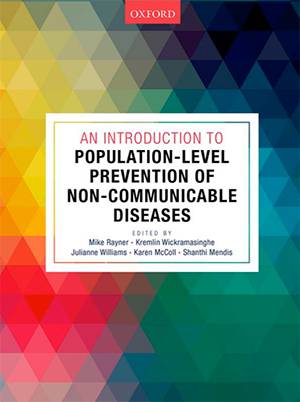New Book 'An Introduction to Population-level Prevention of Non-Communicable Diseases'
A new book, An Introduction to Population-level Prevention of Non-Communicable Diseases, based on teaching materials and students' case studies from the Department's Prevention Strategies for Non-Communicable Diseases (NCDs) programme, has been produced by the Nuffield Department of Population Health.
The book, published by the Oxford University Press, was officially launched at Rewley House on 13 March 2017. The event featured a talk by Gauden Galea, public health physician for World Health Organisation since 1998, and a panel discussion by Book Editors and course directors Mike Rayner and Kremlin Wickramasinghe, and Julianne Williams of the British Heart Foundation.
What are NCDs?
Non-communicable diseases (NCDs) kill more people than anything else in the world. Defined as a medical condition or disease that is not caused by infectious agents (non-infectious or non-transmissible), NCDs include cardiovascular diseases, such as heart attacks and strokes; cancers; chronic respiratory diseases, such as chronic obstructed pulmonary disease and asthma; and diabetes.
In 2013, the World Health Organization published a global action plan for the prevention and control of NCDs which set a target to reduce death rates from NCDs by 25% by 2025. In response, countries have been drawing up national-level NCD prevention policies and programmes. New departments have been created by governments, NGOs, and other organizations to drive this agenda forward, creating a need for capacity building and training.
The new book is a response to this need, and provide a solid introduction to population-based approaches, and bringing together the concepts, evidence, and methods that define it.
Worldwide case studies
An Introduction to Population-level Prevention of Non-Communicable Diseases provides theoretical background and real-life case studies, helping readers to apply the learnings to their day-to-day work. Case studies come from high income countries as well as low and middle income countries.
Said Mike Rayner, Course Director, 'The course team has compiled this book, which is based on the content covered during the Non-Communicable Disease (NCD) prevention short course at the University of Oxford from 2012 - 2015.'
The book will be the main reading material for the Department's Prevention Strategies for Non-Communicable Diseases - a programme run in collaboration with the Nuffield Department of Population Health and The British Heart Foundation Centre on Population Approaches for Non-Communicable Disease Prevention. It is essential reading for anyone working with NCDs, or with an interest in the subject.
This book is structured around the four stages of the policy cycle: 1) Problem definition; 2) Solution generation; 3) Resource mobilisation and implementation; and 4) Evaluation.
Chapters 2-7 focus on problem definition, which involves understanding the burden of NCDs, its risk factors, the socio-political landscape, the role of advocacy and screening and surveillance.
Chapters 8-10 are about solution generation, which involves examining the evidence for potential costs and benefits of interventions, while also considering contextual factors, including the ethical and political dimensions of different solutions.
Chapters 11-13 are on implementation and the mobilisation of resources, both the money needed for material aspects of the interventions and the people required to plan for and carry out the interventions.
Chapter 14 is about evaluation and monitoring, which may be designed to assess whether or not interventions met their aims and objectives. Given the cyclical nature of the policy cycle, the final chapter is about returning to the various stages. NCD prevention does not always follow the stages of the policy cycle in a strict sequence and often, NCD interventions will need revisiting in light of the experiences and lessons learned from earlier stages.
For more information:
- About the course Prevention Strategies for Non-Communicable Diseases (NCDs) at the University of Oxford Department for Continuing Education
- About the book, An Introduction to Population-level Prevention of Non-Communicable Diseases
Published 13 March 2017

